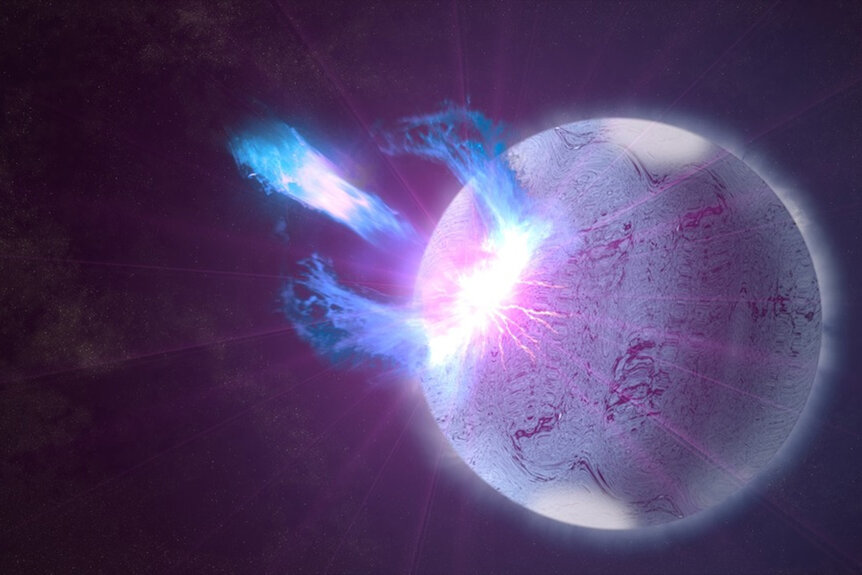Create a free profile to get unlimited access to exclusive videos, sweepstakes, and more!
These Bizarre Radio Signals from Deep Space Keep Getting Weirder
The mystery of fast radio bursts (FRBs) just got another layer.
If aliens are out there, zipping around the cosmos in their high-tech spacecraft, they’re being pretty quiet about it. If Harry Vanderspeigle (star of Resident Alien, streaming now on Peacock) and his buddies are saying anything, they must be using some communications technology we haven’t dreamed up yet.
For decades, scientists have been searching the skies for stray radio signals, hoping to pick up some sign that we aren’t alone in the universe. So far, we haven’t found any smoking phasers but astronomers have picked up some weird radio signals with origins unknown. Recently, one such fast radio burst (FRB) upped the weirdness level when it did something we’ve never seen an FRB do before.
Something Sent Repeating Fast Radio Bursts into Space for Months
Our knowledge and understanding of FRBs is still in its infancy. The fist FRB was discovered only in 2007, when astronomers were sifting through archival pulsar data. Since then, astronomers have identified hundreds of FRBs from points all over space, but we don’t precisely know what they are or what causes them.
RELATED: A Single Object Ripped Out Over 1,600 Fast Radio Bursts in Just a Few Days and No One Knows Why
What we do know is that FRBs are highly energetic, producing incredibly bright but brief flashes of light. The energy released from a single burst contains the combined power produced by the Sun in more than a day, all compacted into an instant. They are usually isolated events, which makes them difficult to study. You usually can’t plan to observe them and have to get lucky, but occasionally an FRB repeats, giving astronomers an opportunity to aim their telescopes.
That’s what happened in the fall of 2022, when astronomers detected FRB 20220912A, a highly active, repeating FRB. Astronomers used SETI’s Allen Telescope Array (ATA), a custom-built telescope array at the Hat Creek Observatory in California’s Cascade Mountains. The array is capable of observing in a wide range of frequencies and can even check out multiple targets at once.
Astronomers pointed the ATA at FRB 20220912A for a total of 541 hours over the course of several months and recorded 35 individual radio bursts. FRBs commonly drift from high to low frequencies over time, and this one was no exception, but astronomers noticed an additional characteristic they had never seen before. Each of the bursts had an unusual dropout in the middle frequencies which researchers described as sounding like a slide whistle when the data was translated to sound.
RELATED: NASA Prepping New Laser Communication System For Astronauts On Mars, The Moon
“This work is exciting because it provides both confirmation of known FRB properties and the discovery of some new ones. We’re narrowing down the source of FRBs, for example, to extreme objects such as magnetars, but no existing model can explain all of the properties that have been observed so far,” said lead author Dr Sofia Sheikh, in a statement.
As to the origin of FRBs, they could be alien broadcasts but let’s be honest… that’s an awful lot of power to burn just to say hello to your galactic neighbors. There’s likely a more mundane but still radical explanation. One popular hypothesis involves magnetars, highly magnetized neutron stars. Another involves the collision of two or more white dwarfs and the burst of energy which might be released in the aftermath. It’s probably definitely not alien communication, but there is no explanation of FRBs that doesn’t make the universe more interesting.
If you want to see an alien for sure, you’ll find him on Resident Alien, streaming now on Peacock.

































